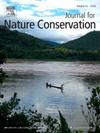巴西南大西洋森林生物群纯种植和混合种植的恢复效果
IF 2.5
3区 环境科学与生态学
Q2 BIODIVERSITY CONSERVATION
引用次数: 0
摘要
种植原生树种是目前应用最广泛的加速初始植被覆盖的主动恢复技术。本研究旨在确定大西洋森林生物群系最南端不同利用历史区域的森林恢复模式对森林恢复轨迹的影响。分析了苗木库(SB)和土壤动物(EF)的组成、密度、多样性和均匀性,以及苗木库中物种的相似性、扩散特征和演替类群,并对与土壤温度和光照有关的非生物因子进行了观测。我们观察到用于种植的本地树种和其他来自周围碎片的再生,主要来自动物的分散。植被提供的树冠降低了林下的光照强度,正影响了SB的物种数量,覆盖了不同的演替类群。EF分类类群的组成和密度反映了该地区的恢复水平,因为它们是易受土壤退化影响的生物。单纯或混合种植提供的树冠加速和多样化退化地区的初始恢复过程。这种条件允许建立来自其他邻近碎片的物种。本文章由计算机程序翻译,如有差异,请以英文原文为准。
Restoration effectiveness in pure and mixed plantings in the southern Atlantic forest Biome, Brazil
Planting native forest species is the most widely used active restoration technique to accelerate initial vegetation cover. This study aimed to identify the influence of restoration practices on the forest recovery trajectory in areas with different use histories in the extreme south of the Atlantic Forest Biome. We analyzed the composition, density, diversity, and evenness of the seedling bank (SB) and edaphic fauna (EF), as well as the similarity, dispersal syndrome, and successional group of species in the SB. Abiotic factors related to soil temperature and luminosity were also observed in the areas. We observed the presence of regenerating of native tree species used in the plantings and others from surrounding fragments, mainly from zoochoric dispersion. Tree canopy provided by the plantings reduced the light intensity in the understory, positively influencing the number of species in the SB, covering different successional groups. The composition and density of the EF taxonomic groups indicated the area’s level of restoration, as they are organisms susceptible to soil degradation. Tree canopy provided by pure or mixed planting accelerates and diversifies the initial restoration process of degraded areas. This condition allows the establishment of species originating from other adjacent fragments.
求助全文
通过发布文献求助,成功后即可免费获取论文全文。
去求助
来源期刊

Journal for Nature Conservation
环境科学-生态学
CiteScore
3.70
自引率
5.00%
发文量
151
审稿时长
7.9 weeks
期刊介绍:
The Journal for Nature Conservation addresses concepts, methods and techniques for nature conservation. This international and interdisciplinary journal encourages collaboration between scientists and practitioners, including the integration of biodiversity issues with social and economic concepts. Therefore, conceptual, technical and methodological papers, as well as reviews, research papers, and short communications are welcomed from a wide range of disciplines, including theoretical ecology, landscape ecology, restoration ecology, ecological modelling, and others, provided that there is a clear connection and immediate relevance to nature conservation.
Manuscripts without any immediate conservation context, such as inventories, distribution modelling, genetic studies, animal behaviour, plant physiology, will not be considered for this journal; though such data may be useful for conservationists and managers in the future, this is outside of the current scope of the journal.
 求助内容:
求助内容: 应助结果提醒方式:
应助结果提醒方式:


